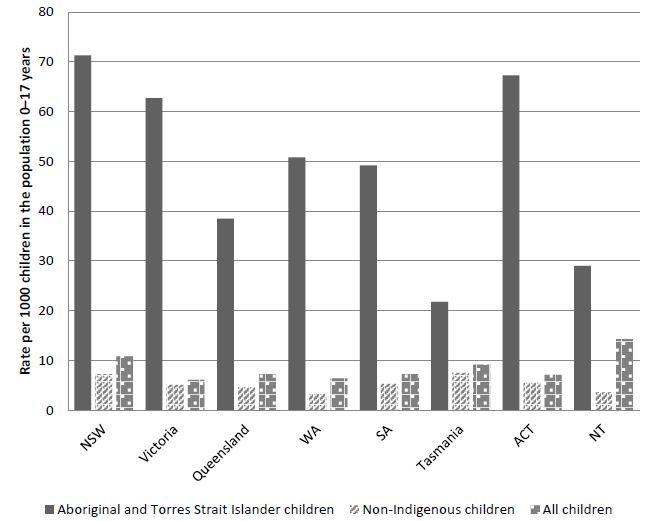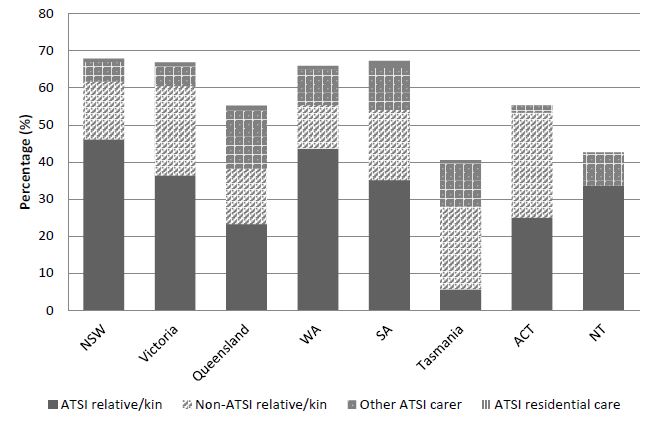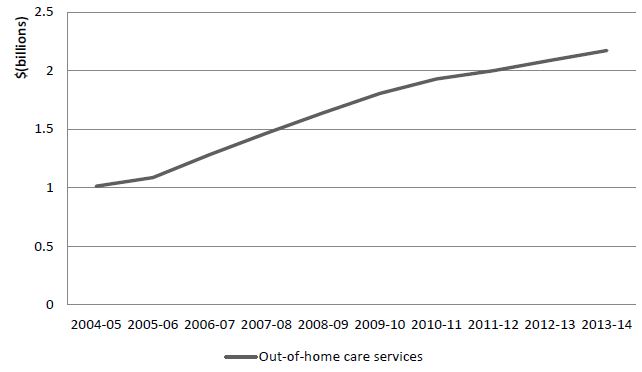Chapter 1
Introduction
1.1
In 2013, the first report to the Australian Parliament by the National
Children's Commissioner highlighted serious concerns about Australia's
out-of-home care system, particularly the significant increase in the number of
children placed in out-of-home care, including disproportionate numbers of
Aboriginal and Torres Strait Islander children.[1]
1.2
Over the past fifteen years, the number of children and young people
entering and remaining in statutory out-of-home care (including relative/kinship
care, foster care and residential care arrangements) has more than doubled.
Aboriginal and Torres Strait Islander children and young people are almost ten
times more likely to be placed in out-of-home care than their peers.
1.3
Evidence suggests that children and young people in out-of-home care experience
poor outcomes across a range of indicators. When the leave care, they are more
likely to experience homelessness, drug and alcohol problems and physical and
sexual abuse than their peers.
1.4
This inquiry addresses the intractable and complex issues facing current
Commonwealth, state and territory governments to improve Australia's child
protection systems to ensure they facilitate positive outcomes for all children
and families affected by out-of-home care.
Establishment of the inquiry
1.5
On 17 July 2014, the Senate referred the following matter to the Senate
Community Affairs References committee (committee) for inquiry and report by
the second sitting week in February 2015:
Out of home care, including;
- drivers of the increase in the
number of children placed in out of home care, types of care that are
increasing and demographics of the children in care;
- the outcomes for children in out
of home care (including kinship care, foster care and residential care) versus
staying in the home;
- current models for out of home
care, including kinship care, foster care and residential care;
- current cost of Australia's
approach to care and protection;
- consistency of approach to out of
home care around Australia;
- what are the supports available
for relative/kinship care, foster care and residential care;
- best practice in out of home care
in Australia and internationally;
- consultation with individuals,
families and communities affected by removal of children from the home;
- extent of children in out of home
care remaining connected to their family of origin; and
- best practice solutions for supporting
children in vulnerable family situations including early intervention.[2]
1.6
On 4 December 2014, the Senate granted an extension of time for
reporting until 13 May 2015.[3]
On 12 May 2015, the Senate granted an additional extension of time for
reporting until 12 August 2015.[4]
On 11 August 2015 and 18 August 2015, the Senate granted further extensions to
18 August 2015 and 19 August 2015.[5]
The committee's areas of interest
1.7
The committee has a long-standing commitment to investigating statutory
and informal child protection systems to improve outcomes for all Australians.
The committee's previous inquiries into past practices of forced adoptions and
child institutionalisation and current practices of grandparents caring for
grandchildren have highlighted and addressed significant issues in the way
governments support children entrusted to state care.[6]
1.8
In this report, the committee examines why so many children and young
people, particularly from Aboriginal and Torres Strait Islander communities,
are entering and remaining in out-of-home care. The committee examines how children
and young people can be better supported to remain with their families, where
possible.
1.9
The committee acknowledges the significant challenge in addressing the
complex and difficult problems facing the out-of-home care system. By bringing
together evidence from across Australia, the committee assesses the size and
scope of the problems in out-of-home care, and possible options to improve the
outcomes for children and young people, their families and their carers.
1.10
The committee examines what works and what doesn't in Australia's
existing out-of-home care systems, and what can be learned from successful
models across Australia and overseas.
Structure of report
1.11
This report has 10 chapters:
-
chapter 2 outlines the current out-of-home care framework in
Australia;
-
chapter 3 examines the drivers for the growth in number of
children and young people in out-of-home care;
-
chapter 4 examines the outcomes for children in out-of-home care
and the standards by which outcomes are measured;
-
chapter 5 explores the outcomes for families affected by child
removal, including early intervention programs;
-
chapter 6 examines the current models and supports across
jurisdictions for foster care, relative/kinship care and residential care,
including best practice models;
-
chapter 7 assesses the suitability of other permanent care
options for children and young people outside, including permanent care orders
and adoption;
-
chapter 8 examines the particular needs of Aboriginal and Torres
Strait Islander children and their communities, including best practice models;
-
chapter 9 examines the particular needs of specific groups, including
children and families with disabilities and migrant or other minority cultural
groups;
-
chapter 10 summarises the committee's recommendations.
Conduct of the inquiry
1.12
The committee advertised the inquiry in The Australian on 17
September 2014. Details of the inquiry were placed on the committee's website
and the committee wrote to over 80 organisations, inviting submissions by 31
October 2014. Submissions continued to be accepted after that date.
1.13
The committee received 108 submissions from a range of individuals and
organisations, including children and parents, foster carers, support
organisations, peak bodies, researchers and state and territory governments. In
addition, the committee received 151 responses to a submission template
prepared by Australian Legislative Ethics Commission. A list of the individuals
and organisations that made submissions is provided at Appendix 1.
1.14
The committee held seven public hearings throughout Australia:
-
Perth on 16 February 2015;
-
Sydney on 18 February 2015;
-
Hobart on 12 March 2015;
-
Melbourne on 20 March 2015;
-
Darwin on 1 and 2 April 2015;
-
Canberra on 16 April 2015; and
-
Brisbane on 17 April 2015.
1.15
Transcripts of the hearings are available on the committee's website,[7]
and a list of the witnesses who gave public evidence at the hearings is
provided at Appendix 2.
Acknowledgements
1.16
The committee is grateful to all individuals, organisations and
governments that have assisted the committee with its inquiry.
1.17
The committee extends its sincere thanks to those children and young
people, parents and carers who shared their personal accounts and experiences of
the child protection system.
1.18
The committee is also particularly grateful for the cooperation of
Commonwealth, state and territory government departments and the non-government
sector in providing assistance to address this significant national issue.
Key concepts
Definition of out-of-home care
1.19
For the purposes of this report, the committee defines out of home care
as services that provide care for children and young people aged 0–17 years who
are placed away from their parents or family home for reasons of safety or
family crisis.[8]
Types of care
1.20
Box 1.1 outlines the five main types of statutory out-of-home care, as
defined by the Australian Institute of Health and Welfare (AIHW).
Box 1.1 – Types of statutory out-of-home care
- Home-based care: placement in the home of a carer who is reimbursed (or
who has been offered but declined reimbursement) for expenses for the care
of the child. This is broken down into the three subcategories:
- relative/kinship care—where the caregiver is a relative (other than
parents), considered to be family or a close friend, or is a member of
the child or young person’s community (in accordance with their
culture) who is reimbursed (or who has been offered but declined
reimbursement) by the state or territory for the care of the child;
- foster care—where the care is authorised and carers are reimbursed
(or were offered but declined reimbursement) by the state or territory
and supported by an approved agency; and
- other home-based out-of-home care: home-based care which does
not fall into either of the above categories.
- Residential care: where placement is in a residential building whose
purpose is to provide placements for children and where there are paid staff;
- Family group homes: homes for children provided by a department or
community-sector agency which have live-in, non-salaried carers who are
reimbursed and/or subsidised for the provision of care;
- Independent living: including private board and lead tenant households;
and
- Other: includes placements that do not fit into the above categories and
unknown placement types. This includes boarding schools, hospitals,
hotels/motels and the defence forces.
Source: AIHW, Child
Protection Australia 2013–14, AIHW: Canberra, 2013, Box 5.2.
Informal care
1.21
The committee acknowledges that in addition to children and young people
in statutory out-of-home care placements, a large number of Australian children
are cared for in informal arrangements with relatives and kin.[9]
Ms Meredith Kiraly from the University of Melbourne estimated that there are at
least three times as many children in informal relative/kinship arrangements
than statutory relative/kinship placements.[10]
Dr Marilyn McHugh from the Social Policy Research Centre (SPRC) at the
University of NSW submitted that in relation to informal care arrangements, 'we
know very little about the circumstances of the overall number of informal
(private) kinship carers or the children in their care'.[11]
1.22
Consistent with the findings of the committee's 2014 inquiry, Grandparents
who take primary responsibility for raising their grandchildren, the
committee acknowledges that informal kinship carers play a significant role in
the lives of children for whom they care, but do not receive an adequate level
of recognition or financial and practical support.[12]
Support for children and young people in relative/kinship placements will be
examined in detail in Chapter 6.
Key out-of-home care trends and statistics
Increase in number of children in
out-of-home care
1.23
According to AIHW's Child Protection Australia 2013–14 report, at
30 June 2014, there were 43 009 Australian children in out-of-home care. This
equates to a rate of 8.1 per 1000 children in the population aged 0–17 years.[13]
1.24
Over the past fifteen years, the number of children in out-of-home care
has more than doubled. Statistics compiled by the Australian Institute of
Family Studies (AIFS) show that from 1999–2000 to 2013–14 the total number of
children in out-of-home care has increased from 16 923 to 43 009.[14]
Figure 1.1 shows the sharp increase in the number of children in out-of-home
care over the past decade.
Figure 1.1 – Number of children in out-of-home care, 2004–05 to 2013–14

Source: Productivity
Commission, Report on Government Services 2015, Table 15A.18.
1.25
At 30 June 2014, across jurisdictions the rate of children in
out-of-home care per 1000 children in the population aged 0–17 years was
highest in the Northern Territory (14.3) and New South Wales (10.8) and lowest
in Victoria (6.1) and Western Australia (6.4). Figure 1.2 shows the rate of
children in out-of-home care per 1 000 children in the population across
jurisdictions.
Figure 1.2 – Rate of children in out-of-home care per 1000 children aged 0‑17
years in the population across jurisdictions at 30 June 2014

Source: Productivity
Commission, Report on Government Services 2015, Table 15A.18.
Increase in relative/kinship care
1.26
Relative/kinship care placements account for the largest proportion of
out-of-home care placements. According to AIHW, in 2012–13, 93.4 per cent of
children in out-of-home care were in home-based placements, including 47.9 per
cent placed with relatives or kin.[15]
1.27
Over the past decade, the number of children in relative/kinship
placements has continued to increase. Figure 1.3 shows the increase in the
number of placements by the three main types of care since 2004–05,
highlighting the growth in kinship care.
Figure 1.3 – Number of children in out-of-home care by
placement type, 2004–05 to 2013–14

Source: Productivity
Commission, Report on Government Services 2015, Table 15A.19; AIHW, answer to
question on notice, 16 April 2015 (received 20 May 2015).
1.28
Across jurisdictions, relative/kinship placements account for the
largest proportion of out-of-home care placements in New South Wales, Victoria,
Western Australia, South Australia and the ACT.[16]
Figure 1.4 shows the proportion of placements types at 30 June 2013 across
jurisdictions.
Figure 1.4 – Proportion of children in main types of care across
jurisdictions, 30 June 2013
* In the NT's client information
system, the majority of children in a relative/kinship placement are captured
in the foster care placement type.

Source: AIHW, Submission 22, Table 6.
Over-representation of Aboriginal
and Torres Strait Islander children
1.29
Aboriginal and Torres Strait Islander children are significantly
over-represented in the out-of-home care system. Aboriginal and Torres Strait
Islander children and young people account for less than five per cent of all
Australian children and young people, but account for almost 35 per cent of the
out-of-home care population.[17]
According to the latest figures from the Productivity Commission, Aboriginal
and Torres Strait Islander children are over nine times more likely to be in
out-of-home care than non-Indigenous children.[18]
1.30
Between 2004–05 and 2013–14, the rate of Aboriginal and Torres Strait
Islander children in out-of-home care per 1 000 children in the Aboriginal and
Torres Strait Islander population aged 0–17 years has more than doubled from
21.5 to 51.4 compared to 4.9 to 8.1 for non‑Indigenous children.[19]
Figure 1.5 highlights how the rate of Aboriginal and Torres Strait Islander in
out-of-home care has dramatically increased at a disproportionate rate to
non-Indigenous children.
Figure 1.5 – Proportion of children in out-of-home care at 30 June per 1000
children aged 0–17 in the population by Indigenous status, 2004–05 to 2013–14

Source: Productivity
Commission, Report on Government Services 2015, Table 15A.18.
1.31
Across jurisdictions, the rate of Aboriginal and Torres Strait Islander
children in out-of-home care per 1000 children is highest in NSW (71.3), the
ACT (67.3) and Victoria (62.7). Figure 1.6 shows how the rate of Aboriginal and
Torres Strait Islander children in out-of-home care per 1000 children differs
across jurisdictions.
Figure 1.6 – Rate of children in out-of-home care by Indigenous status
across jurisdictions, per 1000 children in the population, 30 June 2014

Source: Productivity
Commission, Report on Government Services 2015, Table 15A.18.
1.32
Across jurisdictions, the proportion of Aboriginal and Torres Strait
Islander children and young people in out-of-home is highest in the Northern
Territory (85 per cent), Western Australia (51 per cent) and Queensland (40 per
cent). Figure 1.7 shows the proportion of Aboriginal and Torres Strait Islander
and non-Indigenous children and young people in out-of-home care at 30 June
2014.
Figure 1.7 – Proportion of children in out-of-home care by Indigenous
status and jurisdiction, 30 June 2014

Source: Productivity
Commission, Report on Government Services 2015, Table 15A.18.
Relative/kinship placements for
Aboriginal and Torres Strait Islander children
1.33
According to the Productivity Commission, at 30 June 2014, 68.7 per cent
of Aboriginal and Torres Strait Islander children were placed in accordance
with the Aboriginal Child Placement Principle (see Box 1.2), including:
-
37.8 per cent with Indigenous relatives/kin;
-
15.1 per cent with non-Indigenous relatives/kin; and
-
15.8 per cent with other Indigenous carers or in Indigenous
residential care.[20]
Source: Productivity
Commission, Report on Government Services, Figure 15.11, pp 15.37–15.38
1.34
Across jurisdictions, placement consistent with the principle was
highest in NSW (81.4 per cent) and lowest in Tasmania (40.5 per cent). Figure 1.8
shows the proportion of placements made in accordance with the Aboriginal Child
Placement Principle across jurisdictions.
Figure 1.8 – Aboriginal and Torres Strait Islander children placed in
accordance with the Aboriginal Child Placement Principle by type of care, 30
June 2014

Source: Productivity
Commission, Report on Government Services 2015, Table 15A.24.
1.35
Further examination of the Aboriginal Child Placement Principle will be
discussed in Chapter 8.
Expenditure on out-of-home care
1.36
Dr Marilyn McHugh from the Social Policy Research Centre at the
University of NSW estimates that the total cost of child abuse and neglect to
Australian, state and territory governments is around $6 billion. This includes
the costs of out-of-home care now, and the future costs to the community in
healthcare, education, housing and justice systems, as well as 'productivity
and deadweight losses associated with ongoing welfare payments for those
ill-equipped to participate in mainstream society as a result of their early
trauma and neglect'.[21]
1.37
The Productivity Commission reports on the real recurrent expenditure by
states and territories on out-of-home care services. 'Real' expenditure refers
to expenditure adjusted for general price movements over time, so that
comparisons across years are not affected by inflation.[22]
1.38
Over the past decade, expenditure on out-of-home care services has more
than doubled, from $1 billion in 2004–05 to $2.2 billion in 2013–14.[23]
Figure 1.9 shows the increase in real expenditure on out-of-home care services
from 2004–05 to 2013–14.
Figure 1.9 – Real expenditure on out-of-home care services, 2004–05 to 2013–14

Source: Productivity
Commission, Report on Government Services 2015, Table 15A.1.
1.39
The average expenditure on out-of-home care services per child was
$411.24 nationally for 2013–14. Across jurisdictions, the cost per child on
out-of-home care differs widely from $315.92 in Victoria to $1301.16 in
Northern Territory.[24]
Figure 1.10 shows the real expenditure on out-of-home care services per
child across jurisdictions.
Figure 1.10 – Real expenditure per child ($), out-of-home care services,
2013–14.

Source: Productivity
Commission, Report on Government Services 2015, Table 15A.1.
1.40
The drivers for these trends will be examined in Chapter 3.
Committee view
1.41
Like the National Children's Commissioner, the committee is concerned
that the number of children in out-of-home care across jurisdictions has
continued to increase. The committee is particularly concerned by the
disproportionate number of Aboriginal and Torres Strait Islander children in
the out-of-home care system across jurisdictions.
1.42
The continued increase in the number of children and young people entering
out-of-home care and associated costs to government indicates significant
systemic failings at Commonwealth, state and territory levels to support at-risk
families and prevent children entering the child protection system.
Navigation: Previous Page | Contents | Next Page